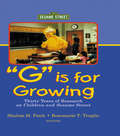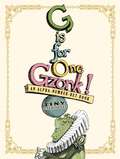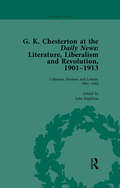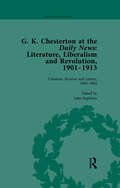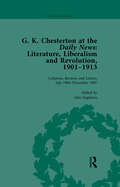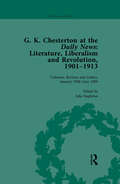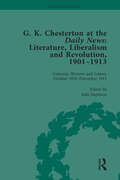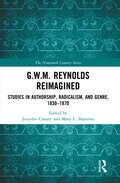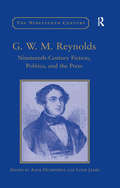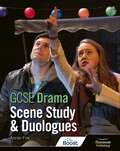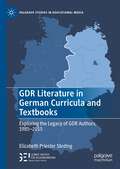- Table View
- List View
G Is for Georgia
by Christopher RobbinsA is for Atlanta B is for Blue Ridge Mountains C is for Civil War With F for the Atlanta Falcons, J for Jekyll Island, and P for Georgia peach, going from A to Z has never been more fun! Take an alphabetized field trip around the Peach State and discover the plants, animals, foods, and places that make it, well, Georgia!
G Is for Gladiator: An Ancient Rome Alphabet
by Michael Shoulders Debbie ShouldersReaders are given an A-Z introduction to ancient Rome, including its social, political, and civil customs and practices. Explores topics such as Roman law, architecture, mythology, etc.
G Is for Golden: A California Alphabet
by David DomeniconiAn alphabet of things characteristic of the stat of California, which consists of a short rhyme for each letter followed by further explanation of the item associated with that letter and its place in California history.
G Is for Granite: A New Hampshire Alphabet
by Marie HarrisDiscover New Hampshire and its rich heritage, unique natural history, and groundbreaking citizens.
G Is for Growing: Thirty Years of Research on Children and Sesame Street (Routledge Communication Series)
by Shalom M. Fisch Rosemarie T. TruglioThis volume--a collection and synthesis of key research studies since the program's inception over three decades ago--serves as a marker of the significant role that Sesame Street plays in the education and socialization of young children. Editors Shalom M. Fisch and Rosemarie T. Truglio have included contributions from both academics and researchers directly associated with Sesame Street, creating a resource that describes the processes by which educational content and research are integrated into production, reviews major studies on the impact of Sesame Street on children, and examines the extension of Sesame Street into other cultures and media. In the course of this discussion, the volume also explores broader topics, including methodological issues in conducting media-based research with young children, the longitudinal impact of preschoolers' viewing of educational versus non-educational television, and crosscultural differences in the treatment of educational content. As the first substantive book on Sesame Street research in more than two decades, "G" is for Growing provides insight into the research process that has informed the development of the program and offers valuable guidelines for the integration of research into future educational endeavors. Intended for readers in media studies, children and the media, developmental studies, and education, this work is an exceptional chronicle of the growth and processes behind what is arguably the most influential program in children's educational television.
G Is for One Gzonk!: An Alpha-number-bet Book
by Tony Diterlizzi Tiny DiterlooneyAges 4-7 Welcome to my silly dilly take on ABC. It's lots of fun and really odd, as you will quickly see. For they're no "leaping lizards" here. No "bears that bounce a ball." In fact, these zany critters have never been seen at all. So turn the page and cast a gaze on this menagerie, but don't forget the beasts within were all made up by me! - Tiny DiTerlooney
G K Chesterton at the Daily News, Part I, vol 1: Literature, Liberalism and Revolution, 1901-1913
by Julia StapletonG K Chesterton (1874–1936) was an important figure in the Edwardian literary world. He engaged closely with the vibrant new influences in literature and reviewed a stream of new editions, biographies, and memoirs for the Daily News. This critical edition includes all of his contributions to the Daily News from 1901 to 1913.
G K Chesterton at the Daily News, Part I, vol 2: Literature, Liberalism and Revolution, 1901-1913
by Julia StapletonG K Chesterton (1874–1936) was an important figure in the Edwardian literary world. He engaged closely with the vibrant new influences in literature and reviewed a stream of new editions, biographies, and memoirs for the Daily News. This critical edition includes all of his contributions to the Daily News from 1901 to 1913.
G K Chesterton at the Daily News, Part I, vol 3: Literature, Liberalism and Revolution, 1901-1913
by Julia StapletonG K Chesterton (1874–1936) was an important figure in the Edwardian literary world. He engaged closely with the vibrant new influences in literature and reviewed a stream of new editions, biographies, and memoirs for the Daily News. This critical edition includes all of his contributions to the Daily News from 1901 to 1913.
G K Chesterton at the Daily News, Part I, vol 4: Literature, Liberalism and Revolution, 1901-1913
by Julia StapletonG K Chesterton (1874–1936) was an important figure in the Edwardian literary world. He engaged closely with the vibrant new influences in literature and reviewed a stream of new editions, biographies, and memoirs for the Daily News. This critical edition includes all of his contributions to the Daily News from 1901 to 1913.
G K Chesterton at the Daily News, Part II, vol 5: Literature, Liberalism and Revolution, 1901-1913
by Julia StapletonG K Chesterton (1874–1936) was an important figure in the Edwardian literary world. He engaged closely with the vibrant new influences in literature and reviewed a stream of new editions, biographies, and memoirs for the Daily News. This critical edition includes all of his contributions to the Daily News from 1901 to 1913.
G K Chesterton at the Daily News, Part II, vol 6: Literature, Liberalism and Revolution, 1901-1913 (The\pickering Masters Ser.)
by Julia StapletonG K Chesterton (1874–1936) was an important figure in the Edwardian literary world. He engaged closely with the vibrant new influences in literature and reviewed a stream of new editions, biographies, and memoirs for the Daily News. This critical edition includes all of his contributions to the Daily News from 1901 to 1913.
G K Chesterton at the Daily News, Part II, vol 7: Literature, Liberalism and Revolution, 1901-1913 (The\pickering Masters Ser.)
by Julia StapletonG K Chesterton (1874–1936) was an important figure in the Edwardian literary world. He engaged closely with the vibrant new influences in literature and reviewed a stream of new editions, biographies, and memoirs for the Daily News. This critical edition includes all of his contributions to the Daily News from 1901 to 1913.
G K Chesterton at the Daily News, Part II, vol 8: Literature, Liberalism and Revolution, 1901-1913 (The\pickering Masters Ser.)
by Julia StapletonG K Chesterton (1874–1936) was an important figure in the Edwardian literary world. He engaged closely with the vibrant new influences in literature and reviewed a stream of new editions, biographies, and memoirs for the Daily News. This critical edition includes all of his contributions to the Daily News from 1901 to 1913.
G is for Grand Canyon: An Arizona Alphabet (Discover America State by State)
by Barbara GowanYes, the magnificent Grand Canyon sprawls across northwestern Arizona. Many of us have been there and many of us will visit it soon, but how much do we know about the rest of this southwestern state? Author Barbara Gowan and illustrator Katherine Larson help elementary-aged students and older readers alike discover the wonders of the Grand Canyon State through rich images, informative expository text, and simple rhymes. G is for Grand Canyon's multi-tiered approach to educating and entertaining assures that this fall thousands of readers will travel through pages from A to Z, in and around and beyond the Grand Canyon.
G. K. Chesterton (Writers And Their Work Series)
by Michael D. HurleyNovelist, essayist, poet, playwright, historian, journalist, Christian apologist, literary and social critic, G.K. Chesterton was one of the most protean and prolific writers of his age, perhaps of any age. Bernard Shaw called him a 'colossal genius'. Most readers have certainly found him too big to see whole, and have therefore cut him in half. The 'poet' is severed from the philosopher; he is treated either as a phrase-maker or as a mystic; his quirky writings are enjoyed as an aesthetic end in themselves, or they are praised for their contribution to theology. In this close reading of his work, Michael D. Hurley brings Chesterton's divided selves together. Covering the full range of his diverse genres, Hurley shows how Chesterton thinks through language, in ways that confound attempts to read him as a thinker without first appreciating him as a writer.
G. W. M. Reynolds and His Fiction: The Man Who Outsold Dickens (Routledge Studies in Nineteenth Century Literature)
by Stephen KnightGeorge Reynolds is arguably the most prolific of all nineteenth-century English novelists, reaching an enormous audience through his thirty-six novels. Often selling in very large numbers in weekly one-penny installments, his works were known as by the most popular English novelist ever. Yet today, he remains almost unknown in the canon of English Literature. A serious radical, strongly pro-woman, and a leading Chartist seeking the vote for all men, Reynolds’ vigorous heroines differ notably from the Victorian novelists’ timid norm. He was strongly pro-Jewish and pro-Gypsy, very interested in French and Italian society, but wrote for ordinary English working people. Dickens thought him a dangerous leftist: for all these reasons, he was excluded from the elite literary world. G. W. M. Reynolds: The Man Who Outsold Dickens reestablishes Reynolds as a major figure of mid-nineteenth-century fiction and an author of European range and status. This book examines his massive popularity and notable concern with the problems of ordinary people, especially women, in the complex and often dangerous new world of the modern city. With the support of his wife Susannah, Reynolds’ enormous influence would also make a contribution to the cause of mass political education through his role in the development of popular fiction and journalism. This book is a major innovation in the field of Victorian literary studies, with relevance to popular cultural studies, the politics of literature, and publishing history, presenting properly a much overlooked major English novelist.
G.U.M. Grammar, Usage, and Mechanics, Level D
by Imogene Dantzler* 2-page lessons that focus on one skill at a time * Proofreading practice and checklists * Activities to get families involved * Review and extra practice * Tests that give students practice with widely used standardized test formats * A convenient Language Handbook * Everything needed for instruction-there's no need to waste time at the copier
G.W.M. Reynolds Reimagined: Studies in Authorship, Radicalism, and Genre, 1830-1870 (The Nineteenth Century Series)
by Mary L. Shannon Jennifer ConaryThis essay collection proposes that G.W.M. Reynolds’s contribution to Victorian print culture reveals the interrelations between authorship, genre, and radicalism in popular print culture of the nineteenth century. As a best-selling author of popular fiction marketed to the lower classes, and a passionate champion of radical politics and "the industrious classes," Reynolds and his work demonstrate the relevance of Victorian Studies to topics of pressing contemporary concern including populism, working-class fiction, the concept of ‘originality’, and the collective scholarly endeavour to ‘widen’ and ‘undiscipline’ Victorian Studies. Bringing together well-known and newly-emerging scholars from across different disciplinary perspectives, the volume explores the importance of Reynolds Studies to scholarship on the nineteenth-century. This book will appeal to students and scholars of the nineteenth-century press, popular culture, and of authorship, as well as to Victorian Studies scholars interested in the translation of Victorian texts into new and indigenous markets.
G.W.M. Reynolds: Nineteenth-Century Fiction, Politics, and the Press (The Nineteenth Century Series)
by Anne HumpherysG.W.M. Reynolds (1814-1879) had a major impact on the mid-Victorian era that until now has been largely unacknowledged. A prolific novelist whose work had a massive circulation, and an influential journalist and editor, he was a man of contradictions in both his life and writing: a middle-class figure who devoted his life to working class issues but seldom missed a chance to profit from the exploitation of current issues; the founder of the radical newspaper Reynolds Weekly, as well as a bestselling author of historical romances, gothic and sensation novels, oriental tales, and domestic fiction; a perennial bankrupt who nevertheless ended his life prosperously. A figure of such diversity requires a collaborative study. Bringing together a distinguished group of scholars, this volume does justice to the full range of Reynolds's achievement and influence. With proper emphasis on new work in the field, the contributors take on Reynolds's involvement with Chartism, serial publication, the mass market periodical, commodity culture, and the introduction of French literature into British consciousness, to name just a few of the topics covered. The Mysteries of London, the century's most widely read serial, receives the extensive treatment this long-running urban gothic work deserves. Adding to the volume's usefulness are comprehensive bibliographies of Reynolds's own writings and secondary criticism relevant to the study of this central figure in mid-nineteenth-century Britain.
GCSE Drama: Scene Study and Duologues
by Annie FoxWritten by a highly experienced and respected Drama teacher and Author, Annie Fox, this comprehensive resource offers detailed guidance on how to approach performing duologues for the GCSE Drama course. It aims to help students have the most positive possible experience of performing duologues, from choosing ones that suits their skills, supporting their rehearsals and trouble-shooting common problems.- Provides guidance on how to select a duologue, including the choice of character, content and genre.- Includes a large selection of exemplar duologues for performance practice, each with a summary of the setting and characters, as well as notes to aid in understanding and breaking down the scene.- Offers advice and tips on how to rehearse and troubleshoot common issues such as forgetting lines and ensuring students demonstrate a range of skills.- Covers a wide range of genres and styles, including the horror thriller Let the Right One In, the friendship drama Out of Love and the hilarious fantasy comedy, Alice.- Supports all GCSE Drama specifications including AQA, OCR, Edexcel and WJEC/Eduqas, and offers high-quality support you can trust.
GDR Literature in German Curricula and Textbooks: Exploring the Legacy of GDR Authors, 1985-2015 (Palgrave Studies in Educational Media)
by Elizabeth Priester StedingThis book analyzes the changing portrayal of GDR literature in German Gymnasium textbooks 1985-2015. Addressing the need for textbook research to broaden its focus from GDR history to GDR literature, the author presents case studies of well-known GDR authors (Bertolt Brecht, Johannes R. Becher, Anna Seghers, Wolf Biermann, and Christa Wolf), each examining a particular aspect of the societal discourse about GDR literature and the tension between (literary) text and (historical) context. Taken together, the case studies reveal the frequently underestimated power of ideology in literature textbooks. They also show how attempts to package these authors into simplified categories ultimately reveal the profound complexities of the GDR literary legacy. By examining the clear tension between literature and politics in textbooks and curricula, the author demonstrates how ideological messages are transmitted in all textbooks, as well as the importance of attending to overt and covert ideology.




